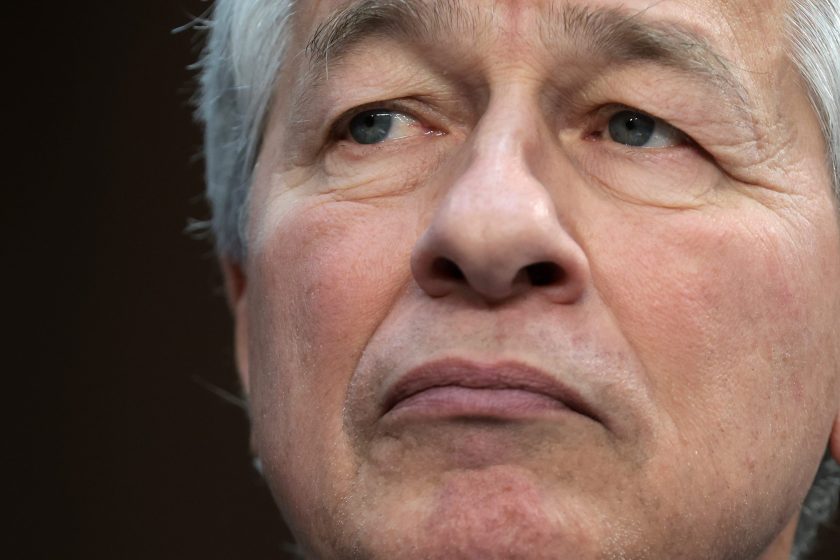 JPMorgan Chase & Co. CEO Jamie Dimon isn’t exactly an optimist on Wall Street, and seemingly rosy economic data won’t change his mind. Winn McNamee—Getty Images
JPMorgan Chase & Co. CEO Jamie Dimon isn’t exactly an optimist on Wall Street, and seemingly rosy economic data won’t change his mind. Winn McNamee—Getty Images
JPMorgan Chase & Co. CEO Jamie Dimon is rarely one of Wall Street’s most optimistic voices, and despite rosy data coming out of the U.S. economy, he Not sure.
Analysts are buoyed by better-than-expected labor data, consumer resilience and indications from Chairman Jerome Powell that interest rates could start falling this year.
This could suggest a “Goldilocks” scenario that some economists believe. The data is neither too hot to lead to rampant inflation nor too cold to crush corporate profits.
Although he has had to admit that some bears have been too negative, Dimon is not satisfied with bullish claims that the market will weather the next few years without incident.
Highly paid bank leaders are already sounding the alarm about government debt levels, agreeing that it is the “most predictable crisis” currently facing the U.S. economy. Mr. Dimon told the Bipartisan Policy Center last month that this was still a long way off, but this week he suggested there could be other challenges in the short term.
Speaking at JPMorgan’s High Yield Leveraged Finance Conference in Miami this week, Dimon said 2024 has been “very good so far” with more M&A talk and confidence continuing to rise. Ta.
But “market thinking changes quickly,” Dimon told CNBC. Fast Money Halftime Report. Furthermore, he added: You were feeling great before the crash, but then things change. ”
Indeed, although the 1970s began with positive talk of rising employment levels and fiscal stimulus, it quickly descended into rampant inflation and recession, with interest rates rising to over 16% by 1981.
Dimon is not the first to worry about going back 50 years. Deutsche Bank also said in October that it saw “a surprising number of similarities” with the 1970s.
“We have to look ahead,” Dimon continued. Dimon was paid a record $36 million for his work in 2023. [that] we are watching. ” Wall Street giants have been open about what factors they think could lead to surprises, including stronger-than-expected inflation, government debt, and geopolitics.
Dimon added that the reason the economy is doing so well right now is because of government spending and its synergies, adding that the market is “in some sense pricing in a soft landing, and the possibility of that happening.” There are enough,” he added. The odds are 70 or 80, but I’d say half that. ”
He said it was “very likely” that the US would have a soft landing, but added: “It’s also likely that interest rates will be a little higher than the market thinks.”
Additionally, Dimon said: “It is always a mistake to look only at the year. All these factors we talk about: QT [quantitative tightening], fiscal spending, deficits, geopolitics, they can play out over multiple years, they play out, they have an impact, and we don’t know what it is. That’s why I’m cautious about everything. ”
We can’t go back to the crisis of 2008.
Interestingly, the area where Dimon seemed more optimistic was commercial real estate.
After the pandemic and the subsequent shift to remote and hybrid working, analysts had worried that defaults would trigger credit problems for banks.
But Dimon tried to dismiss comparisons between the hypothetical commercial real estate crisis and the 2008 credit crunch, citing the difference in size between the commercial and consumer real estate sectors.
In fact, the debt owners in this case (half of commercial real estate debt is owned by banks) have the ability to address this problem, Dimon said.
“I think if there’s no recession, most people will be able to get through this by refinancing or investing in more stocks,” Dimon explained. “And of course, when we say defaults are high, part of it is just a normalization process. They’ve been very low for a long time… they’re not at crisis level. They’re kind of getting back to normal. I did.”
If a recession and rising interest rates occur at the same time, there will be a real estate “problem”, but “some banks will have a much bigger real estate problem than others,” says the 67-year-old. said.
#JPMorgan #Chase #CEO #Jamie #Dimon #isnt #convinced #positive #economic #indicators